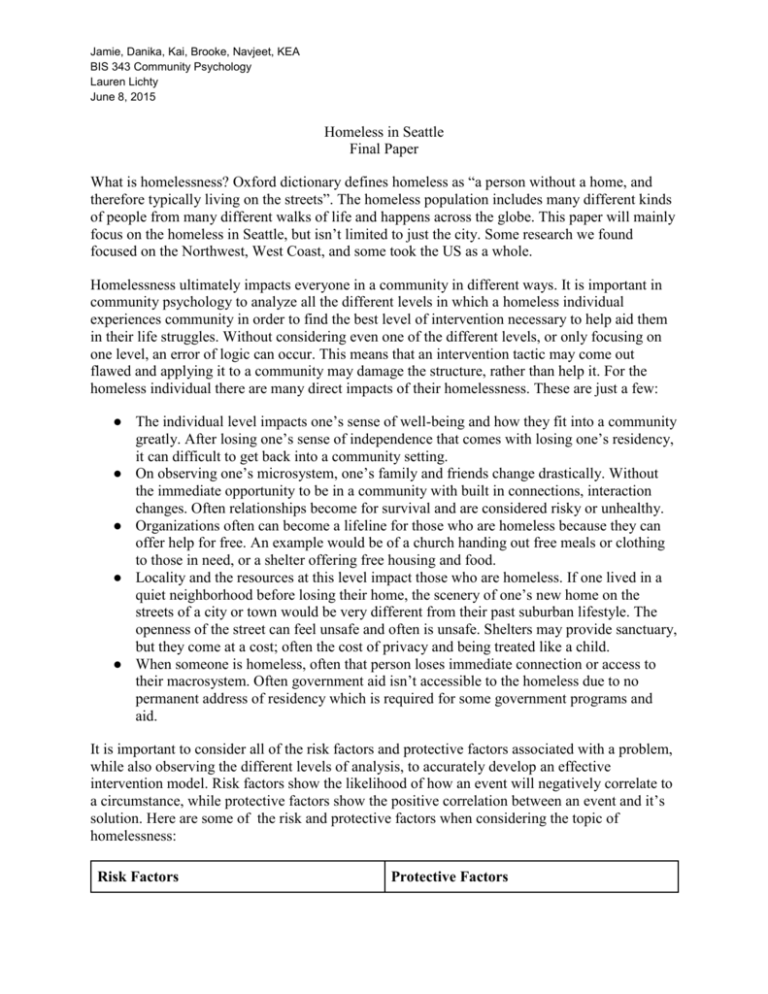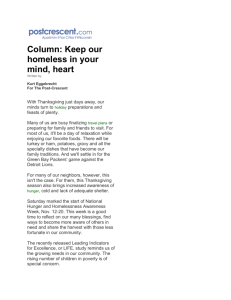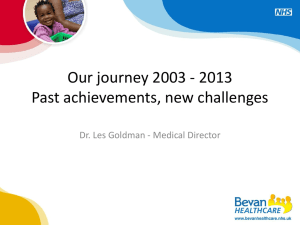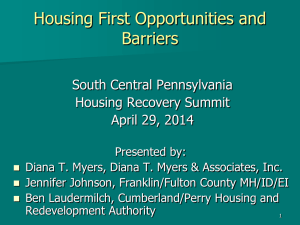
Jamie, Danika, Kai, Brooke, Navjeet, KEA
BIS 343 Community Psychology
Lauren Lichty
June 8, 2015
Homeless in Seattle
Final Paper
What is homelessness? Oxford dictionary defines homeless as “a person without a home, and
therefore typically living on the streets”. The homeless population includes many different kinds
of people from many different walks of life and happens across the globe. This paper will mainly
focus on the homeless in Seattle, but isn’t limited to just the city. Some research we found
focused on the Northwest, West Coast, and some took the US as a whole.
Homelessness ultimately impacts everyone in a community in different ways. It is important in
community psychology to analyze all the different levels in which a homeless individual
experiences community in order to find the best level of intervention necessary to help aid them
in their life struggles. Without considering even one of the different levels, or only focusing on
one level, an error of logic can occur. This means that an intervention tactic may come out
flawed and applying it to a community may damage the structure, rather than help it. For the
homeless individual there are many direct impacts of their homelessness. These are just a few:
● The individual level impacts one’s sense of well-being and how they fit into a community
greatly. After losing one’s sense of independence that comes with losing one’s residency,
it can difficult to get back into a community setting.
● On observing one’s microsystem, one’s family and friends change drastically. Without
the immediate opportunity to be in a community with built in connections, interaction
changes. Often relationships become for survival and are considered risky or unhealthy.
● Organizations often can become a lifeline for those who are homeless because they can
offer help for free. An example would be of a church handing out free meals or clothing
to those in need, or a shelter offering free housing and food.
● Locality and the resources at this level impact those who are homeless. If one lived in a
quiet neighborhood before losing their home, the scenery of one’s new home on the
streets of a city or town would be very different from their past suburban lifestyle. The
openness of the street can feel unsafe and often is unsafe. Shelters may provide sanctuary,
but they come at a cost; often the cost of privacy and being treated like a child.
● When someone is homeless, often that person loses immediate connection or access to
their macrosystem. Often government aid isn’t accessible to the homeless due to no
permanent address of residency which is required for some government programs and
aid.
It is important to consider all of the risk factors and protective factors associated with a problem,
while also observing the different levels of analysis, to accurately develop an effective
intervention model. Risk factors show the likelihood of how an event will negatively correlate to
a circumstance, while protective factors show the positive correlation between an event and it’s
solution. Here are some of the risk and protective factors when considering the topic of
homelessness:
Risk Factors
Protective Factors
Jamie, Danika, Kai, Brooke, Navjeet, KEA
BIS 343 Community Psychology
Lauren Lichty
June 8, 2015
Sickness from exposure to elements
Shelters, housing, tent city communities
Drug use/overdose/health problems
Needle exchange, rehab centers, halfway
housing
Survival sex/prostitution/sex trafficking
*Health centers (planned parenthood STD/STI/HIV/pregnancy testing,
condoms/contraception. hospitals), shelters
Kidnapped and placed in sex trafficking
Police aid, media (wanted posters, community
search teams)
Lack of resources/access to resources: Food,
toiletries
Food aid/food programs, church donation
centers, tent city communities, soup kitchens,
Salvation Army
Physical abuse/Health problems
Helplines, police aid, health centers
STD/STI/Pregnancy/Health problems
Education, contraceptives, *health centers
Potential to drop out of education systems
Stay in school and graduate, GED programs
Violence
Learn self defense, police aid
Crime: Placement in juvenile jail/jail/prison
Non discriminatory resources, family support
Crime: Vandalism, Theft, Petty crime
Non discriminatory resources, shelters, soup
kitchens, clothing banks
Tony Sparks (2010) Broke Not Broken: Rights, Privacy, and Homelessness in
Seattle, Urban Geography, 31:6, 842-862, DOI: 10.2747/0272-3638.31.6.842
An article, Broke Not Broken, found that there have been many scholars who have closely
examined the privatization of public space. This was done through neoliberal urban policies and
planning which resulted in increasing the marginalized urban homelessness. The authors of this
article learned through their research that homeless people want the right to be eradicated from
public view. A common feeling from the homeless population is that being in public view
stigmatizes them. It has made them feel that when in a public space, they are politicized as a
visible embodiment in the form of structural injustice of capitalism and spatial injustice.
Throughout the observations, the researchers found the visibility of the homeless functions as a
signifier for social injustice, homelessness and capitalist development. The authors found that
homeless are framed as differential citizens who are often denied material privacy protections of
the First and Fourth amendments, simply based on their lack of property. Roy (2003, p. 475)
They argue it is ultimately homeless persons’ lack of access to private property and its privileges
that justifies the usurpations of privacy represented by the “spatial techniques of fortification,
eviction, and surveillance that are used to manage the homeless.” This shows the
Jamie, Danika, Kai, Brooke, Navjeet, KEA
BIS 343 Community Psychology
Lauren Lichty
June 8, 2015
marginalization of these people and their right of being considered a proper citizen is being
ignored. Although some have likened the heightened level of state intervention and management
of the homeless to the treatment of refugees, stateless persons, and illegal immigrants, the legal
citizenship status of the homeless is seldom in question (Arnold 2004).
● Homeless people do not want to be identified as homeless.
● Homelessness has signified one’s moral unfitness to exercise the right to bear citizenship·
These people do not want to be stereotyped. They often are stereotyped as drunks, drug
addicts, mentally ill, lazy, deviant, parasitic, diseased and incompetent in the public eye.
● They are treated “less-than-human” because they lack access to a “fixed and legal
residence.”
● They are treated like monitored children in shelters, having to be watched, signing in and
out and being questioned profusely.
SHARE/WHEEL shelters provide these homeless individuals the opportunity to function as
active participatory citizens through their own expression and pursuit of their collective needs
and desires.
Ensign, J. (2004). Quality of Health Care: The Views of Homeless Youth. Health Services
Research, 39(4p1), 695-708. DOI:10.1111/j.1475-6773.2004.00253.x
This article summarized an ethnography done in 2002 on homeless youth from
both street and clinic settings in Seattle, Washington. The purpose of this research was to find
what kind of health care would be most useful and effective for the homeless youth population.
The ethnography was a series of in depth individual interviews, as well as focus groups with a
sample of 47 homeless youth aged 12–23 years. “All interviews and focus groups were tape
recorded, transcribed, and preliminarily coded, with final coding cross-checked and
verified with a second researcher.”
The findings were that homeless youth most often stated interpersonal aspects of health care and
other resources as being important to them. “Physical aspects of care reported by the youth were
health care sites separate from those for homeless adults, and sites that offered a choice of
allopathic and complementary medicine.” This resulted in many positive outcomes, including:
survival of homelessness, improvement of prevention and treatment for diseases, decrease in
disease rates amongst homeless youth, and increased trust with adults and the wider community.
As a result, homeless youth more likely to reach out for health care, instead of turning to things
such as substance abuse or survival sex.
This article was chosen because it integrated the community psychology models of research,
collaboration, integration, and intervention really well. The research was done in collaboration
with the homeless youth community, to hear and integrate their perspectives. This collaborative
approach was taken in order to effectively reform health care systems available to homeless
youth. Scholarly articles specifically on runaway youth were very difficult to find, even though
large portion of homeless youth are runaways. Besides the select few in the 20-23 age range that
were homeless for economic reasons such as lack of housing, jobs, etc.
Jamie, Danika, Kai, Brooke, Navjeet, KEA
BIS 343 Community Psychology
Lauren Lichty
June 8, 2015
In a federal estimate, Seattle is believed to have the fourth largest homeless population in the
country, after Los Angeles, Las Vegas, and San Francisco. A large portion of that are youth or
young adults. The number is approaching an estimated count of 1,000 just in King County.
Experts believe that at least half are runaways, according to Komo. In a national estimate, it was
projected that approximately 1.3million runaway youth live unsupervised, either in the streets or
in “unstable housing” such as couchsurfing. Sadly, around 5000 unaccompanied youth die each
year as a result of assault, illness, or suicide; states the National Council of State Legislatures
(NCSL). According to the 2003 national study done by the NCSL, statistics show that 1/7 youth
ages 10-18 will runaway and youth ages 12-17 are more at risk of being homeless than adults
Despite the frequently stigmatized story surrounding homeless youth, runaway situations often
has very little to do with the individual and has more to do with the intersectionalities of
microsystems, organizations, localities, and/or macro systems surrounding that individual. The
top 3 reasons for running away are:
● Family problems which include (46%) physical abuse, (38%) emotional abuse, (17%)
sexual abuse. There are sometimes just one kind of abuse, however often it is a
combination of these types of abuse that are experienced by the runaway.
● Transitions from foster care and other public systems can leave individuals without
residency and a lack of income to support themselves. Once released from foster care
youth are on their own. Because of admission policies, youth are often not admitted to
shelters, which are just for adults. This puts more youth on the streets than adults and
denies youth access to resources.
● Economic or financial reasons such as difficulty obtaining and maintaining jobs, lack of
affordable housing, and lack of healthcare or other benefits.
In the May of 2015, KOMO News covered a story on runaway youth in the Seattle area. One of
the interviews was with a 23-year-old young adult named Matthew. He had been a homeless
runaway for four years. He told the reporters that when he was a kid, his mom, dad and brother
had all died. Rather than turn to relatives, he turned to the streets, heroin and methadone. KOMO
News asked him: "Matthew, what do you want people to know about the plight of young people
on the streets?" To which Matthew answers: "It's not a game. It's real. Yeah. You look at us like
it's our fault. You know, he must've done something for him to be out here, you know. But I
didn't do anything wrong for me to be out here. It just happened."
Analyzing this from a community psychology lens, these stories are important to keep in mind
for integrating prevention and promotion strategies. These studies and statistics illustrate the
dangers of “a single story” and how a single perspective of a condition can result in severely
damaging a community. One example of this is the recent installment of “anti homeless spikes”
placed under bridges or in other parts of the city that serve as resting spots for homeless
individuals. The goal was to reduce the amount of litter around business buildings. In this case,
the root cause of the issue was misunderstood. Instead of addressing issues that cause
homelessness in the first place, such as lack of affordable housing, lack of jobs, or lack of other
resources; the homeless population was identified as the direct cause of the problem instead, and
spiked were installed to get rid of the “problem”. Manchester resident Cathy Urquhart, who
started a petition against these spikes on Change.org, wrote: “These spikes are an affront to
Jamie, Danika, Kai, Brooke, Navjeet, KEA
BIS 343 Community Psychology
Lauren Lichty
June 8, 2015
humanity. They tell the homeless that they are not welcome, that they are a problem to be moved
on.” Likewise, common social stigmas around runaways youth, such as “lazy”, “juvenile” or
“lacking in discipline”, could result in making the runaway population feeling oppressed and
misunderstood. This in turn could make them less likely to reach out to resources, and more
likely to turn risky behaviors for the sake of survival.
This second example is of a tertiary prevention method that was integrated in collaboration with
the runaway youth population and resulted in more effective and positive change. The prevention
began with a research ethnography done with homeless youth from both street and clinic settings
in Seattle, Washington in 2002. The purpose of this research was to find what kind of health care
would be most useful and effective for the homeless youth population, and was conducted as a
series of individual interviews. The findings were that homeless youth most often stated
interpersonal aspects of health care and other resources were important to them. According to
Ensign, “Physical aspects of care reported by the youth were health care sites separate from those
for homeless adults, and sites that offered a choice of allopathic and complementary medicine.”
Outcomes of these types of health care were survival of homelessness, improvement of disease
or decrease in disease rates amongst homeless youth, and increased trust with adults and with the
wider community making those homeless youth more likely to reach out for health instead of
turning to things such as substance abuse or survival sex (Ensign).
"DESC - Shelter, Housing and Services for Homeless Adults in Seattle."DESC - Shelter,
Housing and Services for Homeless Adults in Seattle. N.p., n.d. Web. 07 June 2015.
In today’s generation we are seeing more and more homeless people out on the streets: has the
numbers of homelessness increased or are they being forced into more concentrated spaces as
they are being pushed out from others? More importantly, are they being helped with their
needs? DESC “opening doors, ending homeless” organization has helped people since 1979.
They help adults who are helpless living with behavioral health disorders and chronic
homelessness. Everyday 2,000 homeless women and men look for the help of DESC but, help is
only provided to those who are in the need of crucial assistance. Numerous times homeless
people are refused and rejected for help because DESC is specifically designed for the homeless
folks that are in fragile need and help. DESC has given many people the hopes of dreaming
again, with the powerful help of providers. Their mission today is not only to offer shelters to the
homeless but to end homelessness in the community we live in today. Their initial operating
style was first-order change. They provided people who needed housing a space to lay their head
down. They have adjusted their perspective to recognize the issue grows deeper than just a
pillow for the night. This new perspective on the homeless conundrum shows potential for
second order change by trying to connect the homeless that come through their doors with
resources to get jobs, and affordable housing options.
VAN LEEUWEN, J; et al. Lesbian, gay, and bisexual homeless youth: an eight-city public health
perspective, Child Welfare. 85, 2, 151-170, Mar. 2006. ISSN: 0009-4021
With the count at approximately 1.6 million homeless youth in the United States each year, it’s
important to take this topic with care. This article shows the specific needs that LGBTQ
Jamie, Danika, Kai, Brooke, Navjeet, KEA
BIS 343 Community Psychology
Lauren Lichty
June 8, 2015
homeless youth have compared to their non-gay homeless youth counterparts. The reasoning
behind these extra needs is because in contrast to their non gay counterparts, LGBTQ homeless
youth face a number of added problems including drug use, survival sex (prostitution), physical
and sexual abuse, mental illness, increase in HIV risk, and increased suicide rates. All of these
added problems lead to increased stress levels. By adding resources specific to their needs, they
can then develop better coping methods to battle additional stress. Stress can be broken up into
two different levels of stress: distal contextual factors, and distal personal factors.
Distal contextual factors are those that, “include ongoing environmental conditions that may
interact in various life domains” (Kloos, 255), while distal personal factors can be described as
individual conditions that aren’t easy to see at first. Often they are problems that the individual
doesn’t voluntarily control, such as specific attributes or genetics. What these both have in
common is that they can both act as stressors or resources in an individual’s life. Homeless
LGBTQ youth are experiencing a mix of distal contextual factors and distal personal factors that
add up to a strong sense of stress in their lives. Their largest distal contextual factor they face
would be their inability to find a home and societies lack of view of diversity among sexualities.
Their toughest distal personal factor would be the fact that they identify as lesbian, gay, bisexual,
transgender, queer, or something else. The article concludes by saying that the additional needs
of LGBTQ homeless youth should be observed and studied deeper by child welfare services to
build additional resources or coping additional coping methods, specific to the needs of LGBTQ
homeless youth.
Unlike the homeless adult population, homeless youth are often discriminated against or
withheld access to resources such as high-paying jobs with benefits, health insurance, savings,
and other community resources (Zerger, 824-5). Lack of these fundamental resources leads
homeless youth to engage in risky sexual behaviors in exchange for basic necessities like food,
water, clothing, and shelter (Zerger, 825). These behaviors often times lead to physical and
sexual violence and drug abuse (Zerger, 830). An estimated 70-97% of homeless youth reported
abuse drug and/or alcohol (Zerger, 832). Depending on their age and the duration of their
homelessness, that number increases (Zerger, 832-3). The population of homeless youth who are
also struggling with addiction is both common and very high, however engagement in any type
of drug or alcohol treatment has been very challenging (Zerger, 833). Part of the reason is
because treatment is often times not sought or homeless teens leave treatment before having fully
recovered (Zerger, 833). Studies show through organizational prevention programs, both
homeless and runaway youth have reported reduced drug dependence (Zerger, 830).
Homeless youth are often underrepresented in studies since the term homeless only encompasses
those who are actively using services like shelters and clinics (Zerger, 826). Few of these studies
address the “hidden” homeless population: those staying with friends or living in substandard
housing (Zerger, 826). Homeless youth are also overrepresented (Zerger, 835). They are clumped
into the same category as immigrants, racial and sexual minorities, physically and sexually
abused victims, emancipated youth, and those who are “aging out” of foster care (Zerger, 835).
Jamie, Danika, Kai, Brooke, Navjeet, KEA
BIS 343 Community Psychology
Lauren Lichty
June 8, 2015
SOURCES
Burnside, J. (2015, May 7). Stories of homeless teens: 'I didn't expect myself to be a
runaway' Retrieved June 8, 2015, from http://www.komonews.com/news/local/Youthhomelessness-on-the-rise-in-Seattle-I-didnt-expect-myself-to-be-a-runaway-303008431.html
Covert, B. (2015, February 18). Department Store Installs 'Anti-Homeless' Spikes.
Retrieved June 8, 2015, from http://thinkprogress.org/economy/2015/02/18/3624021/selfridgeshomeless-spikes/
"DESC - Shelter, Housing and Services for Homeless Adults in Seattle."DESC - Shelter,
Housing and Services for Homeless Adults in Seattle. N.p., n.d. Web. 07 June 2015.
Ensign, J. (2004). Quality of Health Care: The Views of Homeless Youth. Health
Services Research, 39(4p1), 695-708. DOI:10.1111/j.1475-6773.2004.00253.x
Homeless and Runaway Youth. (2013, October 1). Retrieved June 8, 2015, from
http://www.ncsl.org/research/human-services/homeless-and-runaway-youth.aspx
Tony Sparks (2010) Broke Not Broken: Rights, Privacy, and Homelessness in
Seattle, Urban Geography, 31:6, 842-862, DOI: 10.2747/0272-3638.31.6.842
VAN LEEUWEN, J; et al. Lesbian, gay, and bisexual homeless youth: an eight-city
public health perspective, Child Welfare. 85, 2, 151-170, Mar. 2006. ISSN: 0009-4021
Zerger, S., Strehlow, A., Gundlapalli, A. (2008). Homeless Young Adults and Behavioral
Health. American Behavioral Scientist, 51, 824-841.








